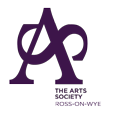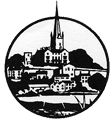Visit to Berlin and Dresden on 15th to 21st September 2015
A very early Tuesday morning start by coach from Ross brought twenty-four members and guests to Birmingham for their 10.00 a.m. flight to Berlin's Tafel Airport. Ahead were two nights in a hotel in what was West Berlin, and four nights based in Dresden, at one time deep in East Germany. A busy itinerary provided an absorbing cultural week which gave an insight into the history of Berlin and Saxony since medieval times, an appreciation of what the Second World War and Communist occupation meant to Eastern Germany; and a realisation of how very much has been achieved since the fall of the Berlin Wall and re-unification.
With the party feeling it had been a long time since breakfast - and with no lunch-stop scheduled - our guide, Wolfgang, used his initiative (and probably gained some commission!). So, our long coach tour of Berlin began in a dedicated café on the Kurfürstendamm, the premier up-market shopping street, with an introduction to a cultural phenomenon: the Currywurst. This is spicy sausage in a curry-flavoured sauce, served with chips and, for the faithful, tomato ketchup. Interesting, but it did not solve the conundrum of why this is, apparently, a Berlin fast-food favourite. Fortunately, the food, from then on, was remarkably good.
Over the course of the next two hours on the coach we were treated to a comprehensive introduction to the sights of central Berlin. Naturally, the Brandenburg Gate was included (with its nearby prominent embassies - USA, France and Russia - but not the British Embassy, which stands aloof elsewhere!); also, the Reichstag, remnants of the Wall and the double line of cobblestones that traces its course through the city. It was apparent just how extensive has been the rebuilding of the war-ravaged city, but on the GDR side of the Wall there are still some buildings which could only be Communist in origin. The area of parks and other green spaces in the centre was remarkable.
After settling in to the hotel the party enjoyed a convivial meal at a nearby restaurant.
Wednesday was dedicated to two notable collections: the Gemäldegalerie and the adjacent Museum of (European) Decorative Arts, both housed in a 1998 building of simple but effective design which re-united some of East and West Germany's works of art. Our guide today was Thomas, of American origin but long-term resident in Berlin. He took us round the Old Masters gallery in the morning, one of the world's greatest collections of 13th to 18th C paintings, giving masterly and lucid explanations of selected artists' techniques. As well as German artists, the works ranged from Raphael, Titian and Caravaggio to many later works from the Low Countries: van Eyck, Bruegel, Rubens, Rembrandt and Vermeer inter alia. The afternoon tour concentrated on 20th C furniture design, medieval church artefacts and the massive array of glass and porcelain, but there was also an interesting range of 19th and 20th C dress.
On Thursday we left West Berlin, crossing the Glienicke Bridge over the Havel, a well-known checkpoint for the exchange of Russian and American prisoners. This took us into Potsdam where the first stop was the Cecilienhof Palace, where Truman, Stalin and Churchill/Attlee met in 1945 to carve up Europe after the German surrender.
The main stop in Potsdam was a guided tour of the elegantly-decorated rooms of the Sanssouci Palace, built by Frederick the Great, who was King of Prussia from 1740 to 1786. This small, single-storey, rococo palace, which stands on a hill overlooking the town, was constructed by the Francophile monarch between 1745 and 1747 as a summer refuge from royal duties in Berlin. The palace and extensive gardens were said to try to rival Versailles - but were on a much smaller scale.
After lunch in a pleasant square back in the town, the coach set off for the 120 or so miles to Dresden, through the low, flat agricultural lands of the North European Plain, and the extensive forests of Saxony. The newly-constructed Holiday Inn was our home for the next four nights: comfortable, with excellent breakfasts, but with a few minor teething problems.
A fairly brief coach tour that evening of the city and its environs, with our guide for the next three days, Suzanne, ensured a reasonable knowledge of where to find things. The main attractions and many good restaurants were less than ten minutes' walk from the hotel - but it seemed always to rain hard en route.
Dresden stands on the Elbe, close to the Polish and Czech Republic borders. The old city centre has been elegantly rebuilt in its former style following the devastation of the saturation bombing and consequent firestorm of 13th to 15th February 1945. Since re-unification it has regained its place as a major cultural, educational, political and economic centre.
Next morning, Suzanne took us for a day at the Green Vault collections, housed in the Royal Palace, home until 1918 of the kings of Saxony. The Green Vault is a museum that contains the largest collection of treasures in Europe. Founded by Augustus II the Strong in 1723, the museum consists of the Historic Green Vault (morning tour) and the New Green Vault (afternoon tour). We heard a lot about Augustus the Strong (nothing to do with the lack of soap in those days) during the course of the holiday!
The Historic Green Vault displays approximately 3,000 masterpieces of jewellery and the goldsmith's art, as well as precious objects made of amber and ivory. Within these treasure chambers, Augustus the Strong presented his treasures to a select public, thus establishing the Green Vault as one of Europe's oldest museums.
Lunchtime in the Nieuw Markt Square gave a chance to visit the Frauenkirche, the very imposing Lutheran church (Catholic until the Reformation), which was totally destroyed in 1945. The GDR left the ruins as a war memorial but, after re-unification, a long process of reconstruction began - to achieve a virtual carbon copy of the original in which many recovered, uncleaned stones are visible in the new structure, placed exactly where they were.
The New Green Vault comprises a collection of elaborate baroque artefacts in gold, silver, precious stones, ivory, enamel and porcelain, some arrayed in set pieces depicting historical events. Mostly from the 16th and 17 C, examples included a large and very detailed sailing ship in ivory, with the incredibly thin mainsails carved from ivory, too; the 41-carat Dresden Diamond incorporated into a hat ornament; and, the pièce de résistance, a cherry stone (sic) on which 113 discernible faces carved in 1589 can be seen through magnifying lenses! Presumably, angels on pinheads were passé by then.
If it's Saturday it must be Meissen! We went there via Morritzburg to view from afar an imposing baroque castle set in stunning symmetry the other side of a lake, the "hunting lodge" of, guess who? Augustus the Strong!
The old town of Meissen is attractive in its own right but, of course, we went first to the showrooms and visitor centre of the porcelain manufactory, owned by the State of Saxony. There we were treated to a display of the processes by which the porcelain is made - but without being given details of the recipe! We also saw the very interesting museum of past works before passing through the shop. Some small purchases were made but, without a mortgage broker on hand, not many.
Next was a drive and walk up to the castle, Albrechtsburg, which stands on a rock outcrop alongside Meissen Cathedral, overlooking the town and the Elbe, downstream from Dresden. The castle was the first place at which hard-paste porcelain was manufactured, once the methodology had been worked out - by alchemist trial and error - and the Chinese monopoly had been broken, under the auspices of (who else?) Augustus the Strong!
The cobbled square was just right for a sunny lunch at one of the hostelries. We then walked down steps into Meissen for a quick look at the old streets and quaint architecture before the short journey back to Dresden.
Sunday morning saw us heading to Pillnitz Castle, alongside the Elbe, about seven miles upstream from Dresden. The edifice comprises the baroque Riverside Palace, the parallel and virtually mirror-image Upper Palace, the other side of extensive formal gardens, and the New Palace at right angles connecting the two. These were erected from 1720 onwards by - you guessed it - A the S! The New Palace burnt down in 1816 and was replaced in Neoclassical style.
In glorious sunshine we explored the splendid gardens and arboretum. A notable feature is one of the four original camellias brought to Europe from Japan in 1776 and re-planted here in 1801. It is now more like a tree than a shrub - nearly thirty feet high - and has beside it a giant greenhouse on tracks that is pushed into place to protect it through each winter. There was just time for a quick tour through the displays in the Upper Palace before we went down to the river to board the river cruiser Dresden for a forty-five minute trip downriver back to the city. The placid river was somewhat buffeted by an almighty rainstorm for part of this.
The afternoon was free to explore the city further or, for the indefatigable, to visit yet more museums and art galleries.
Our last evening was spent together at the Yenidze restaurant in an unlikely building that was erected in the early 20th C to house a cigarette factory disguised as a mosque, with a "minaret" factory chimney that used to glow like a cigarette at the top! No, really. Despite this, the meal was very good and the party could reflect on a very enjoyable, instructive and rewarding - if busy - trip, in very good company.
The journey home, via Berlin and Birmingham, was tiring but largely uneventful, and the coach got us safely back to Ross in the early evening.
Philip Blunden

